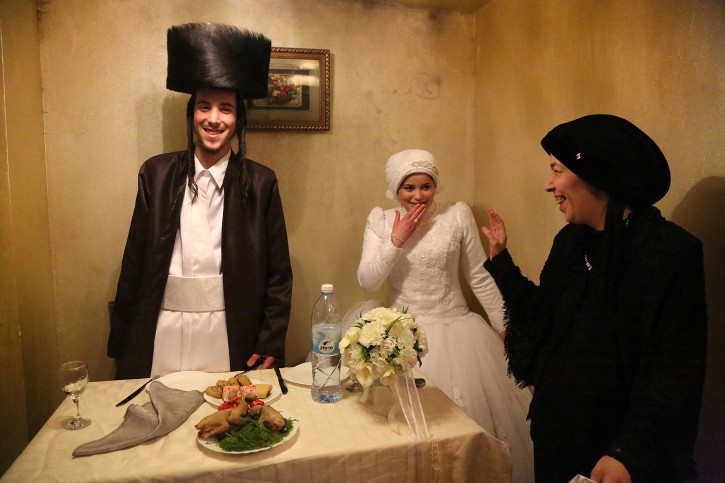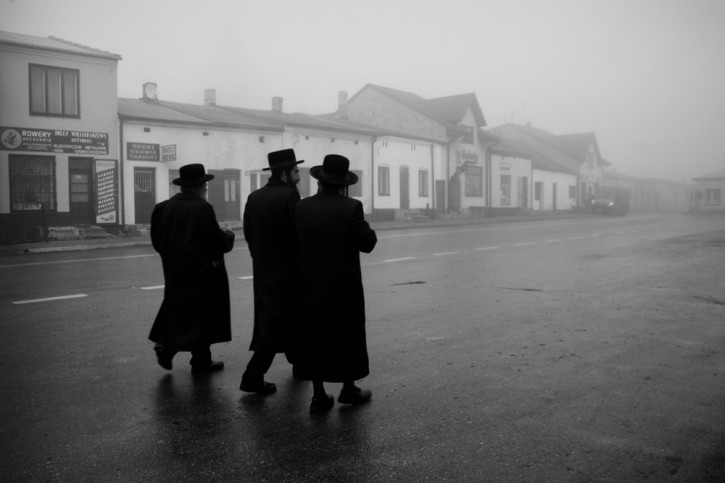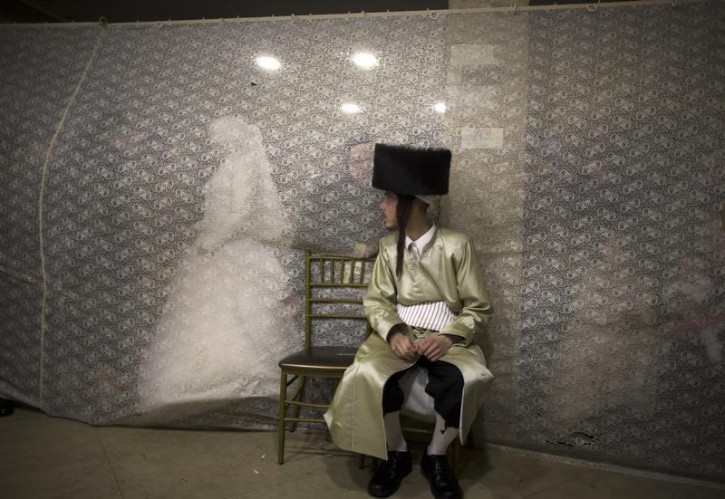 Krakow, Poland – A Polish photographer has taken second prize in a prestigious photo competition with an emotional photo of a Chasidic couple beaming broadly in the yichud room, just moments after emerging from under a Jerusalem chupah.
Krakow, Poland – A Polish photographer has taken second prize in a prestigious photo competition with an emotional photo of a Chasidic couple beaming broadly in the yichud room, just moments after emerging from under a Jerusalem chupah.
Subscribe to our Daily Roundup Email
The picture, titled “First Time” (http://on.natgeo.com/1olJkeD) was taken by Agnieska Traczewska and was one of over 18,000 photos submitted to National Geographic Traveler’s 2014 photo contest.
National Geographic, which has been in publication for over 125 years, is known for its dramatic photos and National Geographic Traveler, launched 30 years ago by National Geographic, is published in the United States with local language editions appearing in 14 other countries. This year’s contest, which ran from March 18th to June 30th, invited photographers to submit photos in the categories of travel portraits, outdoor scenes, sense of place and spontaneous moments.
Traczewska, a professional photographer and film producer, is a resident of Krakow who travels throughout the world in her quest to capture emotional moments but it is the Chasidic Jews who flock to Poland to pray at the graves of their spiritual leaders that are her favorite subjects.
In an exclusive interview with VIN News, Traczewska described her fascination with Judaism.
“I grew up almost never seeing a Jew and ‘Haredi’ Jews, well they were just from pre-war pictures or from the movies,” Traczewska told VIN News.
Observing Chasidic Jews immersed deep in prayer and leaving written prayers behind on tombstones, Traczeswka found herself mesmerized by their deep connection to their heritage.

“With my Polish background and their Polish roots as well, I seek to rediscover a ‘lost world’, traces of Ultra-Orthodox Jews who for centuries, lived side by side with Poles. I try to capture their fundamentally unchanged customs, traditions and history, most of all their necessity of everyday contact and communication with G-d.”
Traczeswka immediately discovered that as a woman, interviewing the men she was photographing proved to be problematic.
“You can imagine a non- Jewish female trying to gain access to Haredi male gatherings, while praying, is no small feat,” said Traczeswka.
Careful to keep her distance and to respect the rules of those she was photographing, Traczeswka slowly forged connections within the Chasidic community, granting her access to a world that is typically closed to outsiders.
“I started my way in Poland where groups of Haredim come for the great tzadikim’s yahrtzeits,” explained Traczewska. “Sometimes I came back to the same shtetl year after year. In Lizhensk I was six times. In Lelov, seven times. Bobov and Rimanov, five times.
Even when I kept a distance and obeyed the rules, I made some connections, which helped my during my first steps in Haredi districts in Israel. People liked my pictures. They understood there is some deeper idea behind my task. Soon I started to make exhibitions from New York to Paris. My work became recognizable.”
Her passion for capturing history of Jewry in Poland had one other unexpected benefit for Traczewska.
“Those travels to the past which I make following Haredim in Poland changed my life,” explained Traczewska. “I started to appreciate what they value so much: the importance of where are you coming from. It’s all about history, tradition and identity which enrich tremendously.”
Traczewska was quick to note that while in the past Poland was noted for its anti-Semitic current, there are many today who devote themselves to preserving the country’s rich Jewish history.
“Being born in Poland, I treat Jewish heritage as part of my own,” said Traczewska. “There are surprisingly many Poles, individuals who as a result of their passion or empathy and compassion, clean abandoned Jewish cemeteries, learn Yiddish to translate forgotten poets of local Jewish authors, make maps of mezuzahs remaining in their neighborhood, renovate the ruins of synagogue and organize the festivals and memorial days. All that requires time, energy, devotion and money and they are doing it, for free.”
For the past five years, Traczewska has traveled repeatedly to Meah Shearim capturing countless images of Jerusalem’s Chareidi community, particularly during the Jewish holiday seasons. Careful to honor local customs and traditions, Traczewska found herself becoming accepted within the tight knit community.
As a friend of the chosson’s family, Traczeska was invited to the February 18, 2014 wedding of Aaron and Rivkeh Krauss, the 18 year old couple featured in the First Time photo, enabling her to capture the radiant chosson and kallah, accompanied by the chosson’s mother.
“I was standing at a narrow corridor outside and could only make a few pictures because after the wedding, the groom is not allowed to look at any woman but his wife,” recalled Traczewska.
Seeing the photograph, Traczewska felt a strong personal connection to the image she captured on her Canon Mark IIID.
“I felt like it was bursting at the seams with emotion,” said Traczewska. “There is love, anticipation, shyness, fondness. On the other hand, one can also feel some fear of the big world ahead, some difficulty in letting go of the sheltering hands of a mother and, of course, the mixture of emotions from the mother: proud, yet timorous, as she knows she will miss her child.”
In a description that appears on National Geographic Traveler’s website, contest judge Dan Westergren, director of photography at National Geographic Traveler, explained what made First Time a prize-worthy photograph.
“When I look at the image I can’t help but think about the nature of love and marriage around the world,” wrote Westergren. “Here is a scene that in many parts of the world could be a young couple on their first date. Because of the clothes they are wearing I know that this is not a lighthearted encounter but the beginning of a lifelong commitment. Any photograph that can make me think that much deserves to be a winner.”

Traczewska, whose picture won her a five day National Geographic photography workshop in Santa Fe, New Mexico, plans to continue capturing the many Chasidim who come to daven in Poland. She is currently seeking a publisher so that she can compile her many photographs into a book.
While her photograph may not feature the typical outdoor vistas that normally win National Geographic prizes, Traczewska feels that First Time is equally powerful.
“National Geographic awards, in general, are associated with spectacular open air scenes,” noted Traczewska. “This year, the first award goes to the fantastic picture of a tornado over Colorado. But in a way, I have the feeling that my photograph is parallel, though. I’ve managed to capture a tornado, indoors. A tornado of feelings, authentic emotions which people miss.”
Placing second in the photo contest was only one reward that Traczewska feels she has reaped through her photographic journey into the world of Chasidic Jewry.
“I have been given so much warmth from the people who I portray for years now,” said Traczewska. “Against all odds we built a bridge of mutual understanding and I am a double winner here. The first award was the trust and friendship in the last place I expected to find it. The second was the National Geographic promotion.”
Traczewska finds her award winning picture to be particularly poignant given today’s difficult situation in Israel.
“Especially during the time of war and negative information which bombs us every day, the picture of the ‘First Time’ carries heart-warming messages: hope of youngsters for love, family and normality,” said Traczewska. “They are happy and we wish them luck.”
Traczewska web site:
http://www.agnieszkatraczewska.com/

To # 1 “These people” are our people. Pehaps,mazel tov!
מאה שערים פאשקעוויל קנאי ר’ יוליש קרויס’ס זון געווינט 2טער נעשנעל זשיאגראפיק מאגאזין קאנטעסט